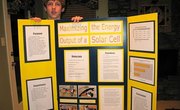Posters are a visual aid and may stand alone, or accompany a scientific report or oral presentation. As such, these documents rely heavily on graphics and pictures to get their point across. A good poster will contain more graphics and empty spaces than text. The title of a poster should be readable from 15 to 20 feet away to entice a walker to come over to your poster and read it. Organize your poster in a pleasing manner to keep your audience reading once you have captured their interest.
Step 1
Designate a title section across the top of the poster. Block out an introduction section in the first section on the upper left corner of the poster. Assign a spot for the conclusion at the end of the poster.
Step 2
Draw out the poster in pencil. Divide the poster into columns. Divide the columns into sections. Divide the sections into subsections as posters are easier to read when divided into small chunks of information.
Step 3
Create an outline with the main points in each section and subsection. Write the text for each. Edit the text until it is less than three sentences per section.
Step 4
Select the visual aids. Illustrate the research results with graphs. Add pictures and showcase the relevant topic information.
Step 5
Vary the text between the extra large to the small fonts for both visual interest and to highlight important information. Be consistent. Keep the same text throughout the poster. Utilize bullet points for important information.
Related Articles
References
Writer Bio
Angelique de la Morreaux began writing articles for various websites in 2010. Her focus is in the legal, small business, beauty, holiday, culture, food, drinks and automotive categories. Morreaux holds a Bachelor of Arts in social sciences from San Diego State University.









